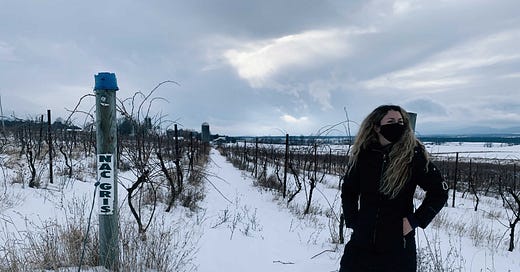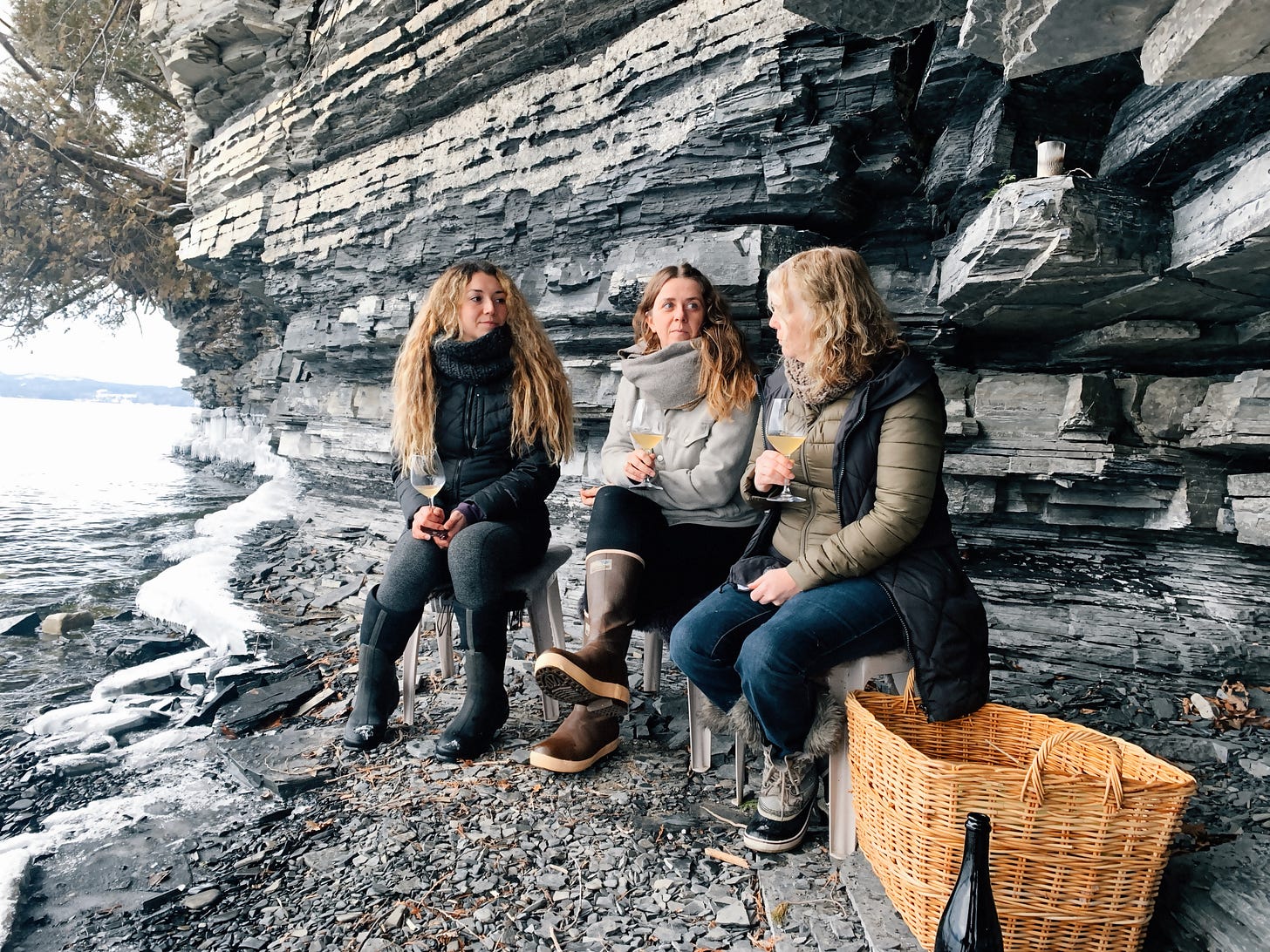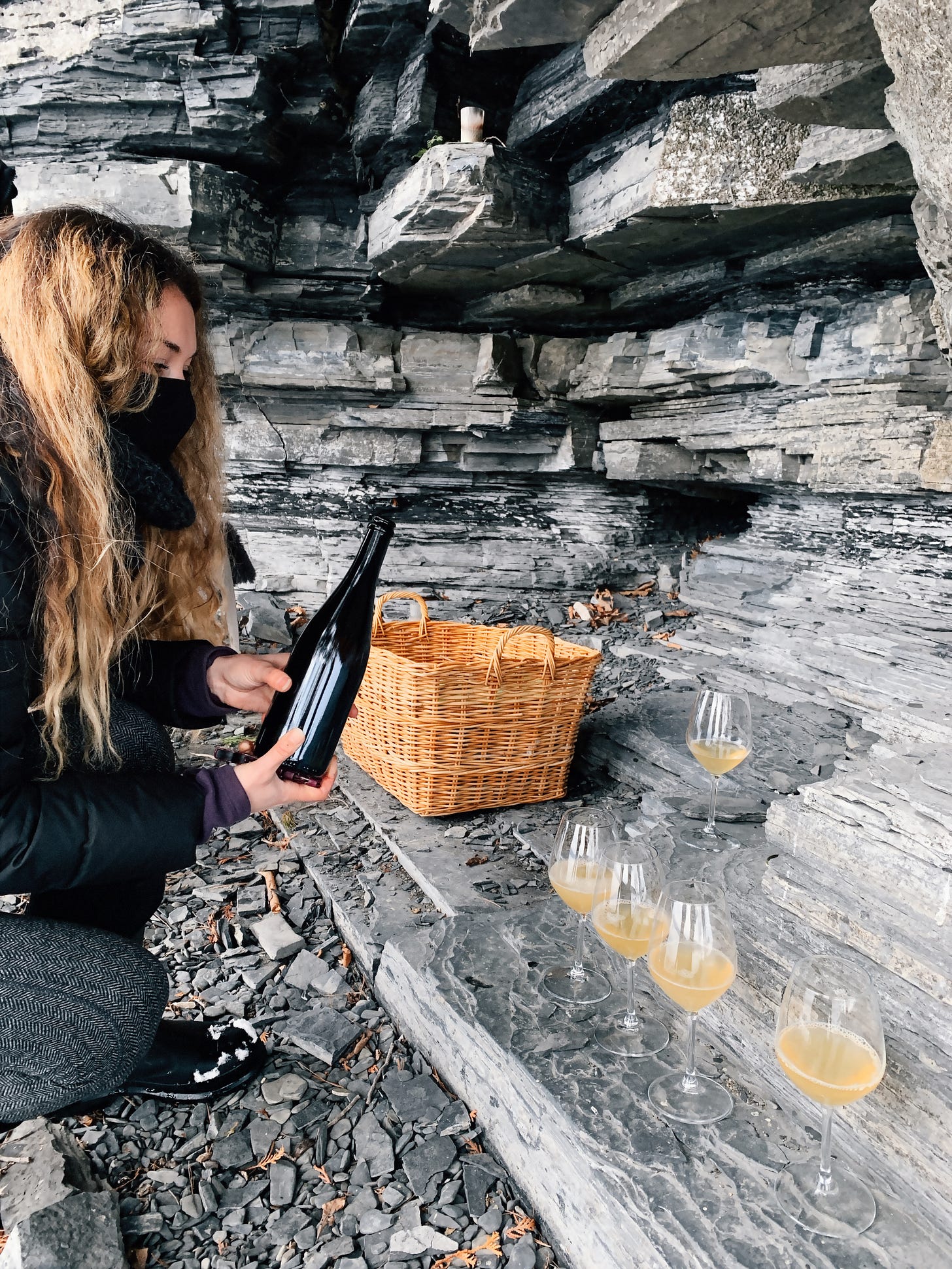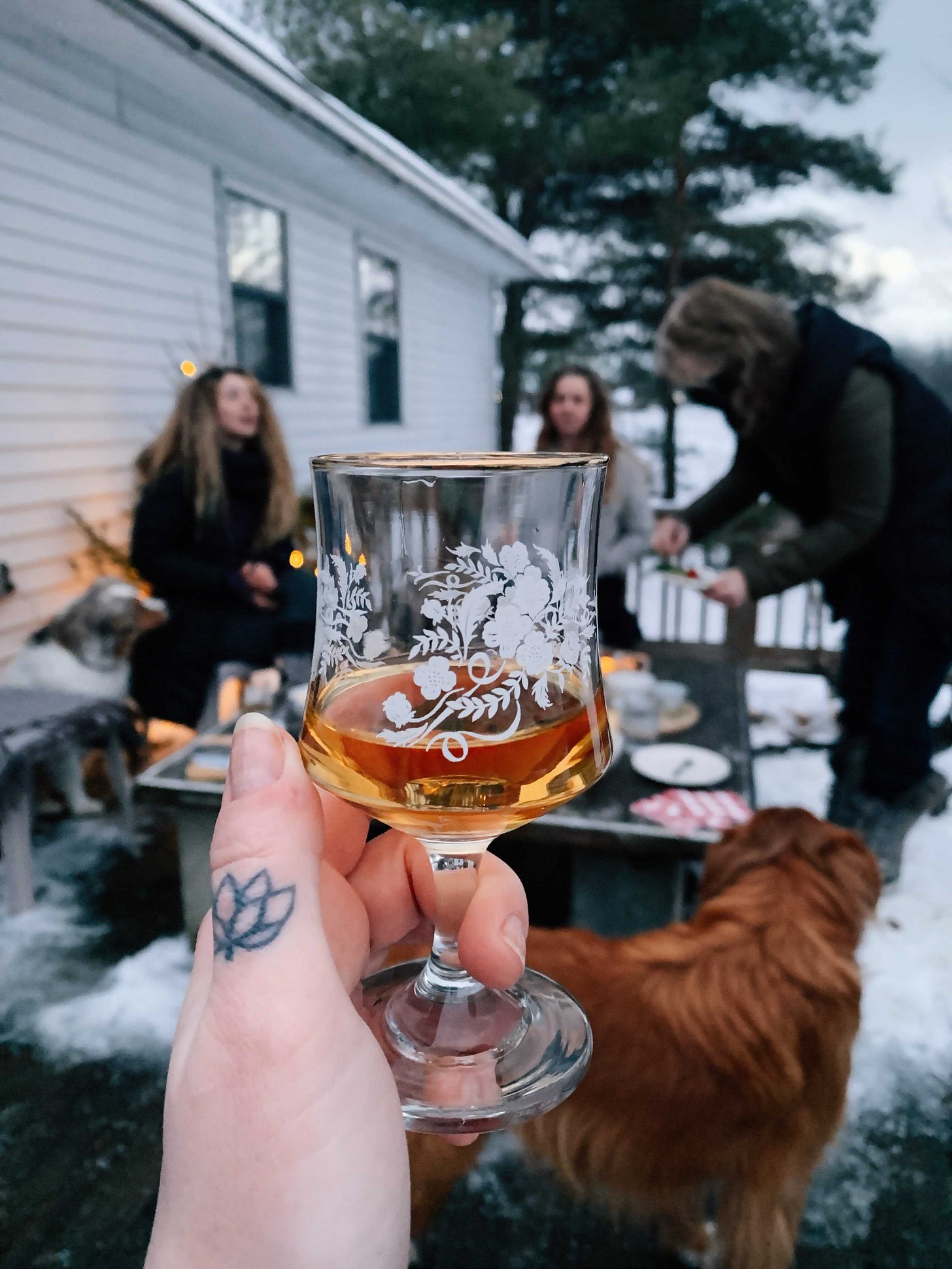The Fizz #7: La Garagista and La Montañuela are uncovering the hidden flor in the hills of Vermont.
I drove up to Vermont to talk to Dierdre Heekin of La Garagista and Camila Carrillo of La Montañuela. We talked about working with hybrids, the Vermont terroir, and their new sherry projects.
For The Fizz issue #7, I drove the three and change hours to Addison, Vermont to see the La Montañuela and La Garagista vineyards and speak with Camila Carrillo and Dierdre Heekin about their wine projects. It was a magical visit spanning two absolutely freezing ten degree days. We drove from vineyard to vineyard, walked on snowshoed paths through the rows, and I got to become familiar with the vines—all hybrid varietals—during their pruning season. We tasted through their wines, all absolutely unique and delightful, all beaming with the soul of New England’s terroir, familiar, yet entirely new and alive.
La Garagista, run by Dierdre Heekin and Caleb Barber, has been a part of Vermont’s winemaking story for 14 years. They focus on biodynamic winegrowing and oxidative styles, showing the inherent nature of the hybrid grape varieties they work with. They lease two vineyards in the Champlain Valley, and have two vineyards at their mountain homefarm. Camila Carillo, the assistant winegrower, has recently started her own project, La Montañuela. Together, these makers are able to create wines that are unlike anything you’ve had from the States—including sherry that naturally forms its own protective layer of flor.
Deirdre: The people who started here, who put in all this infrastructure, they were educated by people who said you can’t farm organically in this part of the country. Some of them had tried to do organic practices and had bad results, so they thought based on their data it was impossible. They were very concerned about protecting their access to fruit.
This vineyard [shown above] has four varieties—Marquette, La Crescent, Frontenac Gris, and Brianna. We’re in our sixteenth or seventeenth leaf here. We’re on clay and limestone, favoring the limestone in this vineyard because of the slope. There are five different clays in the Champlain Valley, limestone, and slate. This whole area used to be the Champlain Sea. You can find sea fossils in many of the parks around the shore—it’s pretty amazing. One of the oldest reefs in the world is down near the West Addison vineyard. Each vineyard has such a different personality.
Frontenac Gris in this vineyard, when it ripens, it gets quite dark and coppery, which sometimes throws really dark rosés for us, and sometimes they’re more salmon—it depends on how much rain we get. They’re quite elegant looking on the vine. Two years ago we chose not to prune the Frontenac Gris block as an experiment in balance. The things we had heard about people working in that way is that it typically takes about three years for a vine to find its balance. We found in the first vintage that there was perfect balance between the vegetation and fruit, and the fruit is completely presented to the sun. I think this precocious behavior is connected to the wild part of a hybrid’s DNA, making them so quickly adaptable. Whereas in the pruned blocks, we are constantly looking for ways to find that balance between vegetation and fruit, and helping the plants figure that out on their own so we’re not doing a lot of labor, and they’re finding that equilibrium.
I got interested in this initially because of the Meinklang wines—their Pinot Gris is unpruned, the Graupert. I was astounded by it, one of the best expressions of Pinot Gris I’ve ever had. We went to go visit them and he talked me through what they were doing, and I thought it was so interesting. I didn’t know if it would work for us, because hybrids are a different animal. They’re extremely vegetative. We did a couple of trials in a couple of different blocks with different varieties, and had a really positive experience, but I probably wouldn’t do it consecutively with our varieties in this climate. For us, it’s a great technique to use cyclically—maybe every five or six years for a block. You’ll get a lot of output in that year. We found that not pruning for a season was very effective in managing disease. It was as if the plant got it out of its system, cleansed itself, because in the next season we saw very little disease, if any, in a similar growing season. It’s a kind of reset, and it is useful for that.
Margot: Do you find that you do more canopy management on the pruned vines?
D: Less and less now. In the beginning, yes, but a lot of the other ideas we’re implementing are helping the plants find that balance so we don’t have to do much canopy management. The Brianna, it’s a monster. You feel like you’re in a jungle. We’ve been doing a later pruning in the Brianna, and that seems to help it rein itself in, and the vegetation not to be as intense and overwhelming. We brought sheep into the vineyard last year for the first time, and they did a lot of cleanup on the trunks and bottom wires. That helped the canopy management. We find that between the tea preparations and our general approach, especially a vineyard this age, it really hits its stride. It felt like maybe two years ago, we hit our stride. When we took over the vineyard, the Marquette was severely diseased—it took us maybe three years to get it healthy, and after six vintages, we really saw the difference take hold. Now, that has become the easiest block to care for—we put so much work into it.
M: You’re working with La Crescent, Marquette, Frontenac Gris. What’s special to you about hybrid grapes?
Camila: The first grape in wine that I ever fell in love with was Pinot Noir. My vineyard is all Marquette, which is a descendent of Pinot. There’s a word in Argentina—Mañoso, someone that needs a lot of care and attention, which was my nickname when I worked over there—a term of endearment. There’s a similarity there to Pinot Noir. Marquette is finicky when it comes to a lot of moisture and humidity, so you have to spend extra attention on it. As soon as there is one diseased berry, you have to spring to action. There’s a fungal disease called anthracnose, they’re these black spots that form on the berries. We alternate between sulfur and copper spraying and mix that with biodynamic teas. You have to go through all the clusters and remove the berries by hand. There’s a lot of hands-on work.
These varieties are special because they’re different. Now that hybrid wines are getting attention, it’s like they’re new, and there’s so much we can do with these varieties—the sky’s the limit. Oxidative style wines, rancio, sherry-style wines, sparkling wines. There’s so much opportunity. Growing grapes in Vermont is special within itself. The varieties, the land, the climate, when you put it together, it’s special. Each year you discover something new and it’s really exciting.
M: What does biodynamics mean to you? Why is it important?
C: I learned everything from Dierdre, and I’m still learning. I’m a spiritual person and in touch with nature. I really believe in how energy has an effect on plants. There’s a connection, and that fuels my interest in biodynamics. I don’t follow it to a tee, but I take certain things from it—doing teas as remedies for bacteria or fungal diseases in the vineyard, for example. We use stinging nettle as one of our main teas in the vineyard throughout the growing season. Now it’s starting to grow around the vineyard—plants know what they need.
With my vineyard, I started with dynamized 500 spray on a leaf day and a flower day. I think it had been sprayed with chemicals in the past and then was left alone for a year, so I did those two 500’s to start fresh. Next year, I’ll do trunk paste—some of my trunks have some disease and vole damage. Voles will chew on new wood at the base of the bark, which starts to kill the trunk. The trunk paste is horn manure, stinging nettle, horsetail, and clay which creates this white paste that attracts sunlight, which is healing for the vines and promotes new growth. I’d like to start experimenting with dandelion teas and other natural remedies—I have a lot to learn.
M: What have you been learning with your project, La Montañuela?
C: My first vintage was in 2018, I made a cider and started the base of my solera projects with La Crescent and Frontenac Gris. 2019 was a little bit bigger—I made 35 cases total. In 2019, during harvest, I connected with this couple who owns this tiny vineyard, less than an acre. They were looking for someone to take care of their vineyard, and I jumped on it. I farm the vineyard in exchange for the fruit which I get for free. They’re incredibly supportive. It’s been an amazing experience. The vineyard hadn’t been farmed for a season so there was a lot of disease in the vines. I had my first harvest from that vineyard this year, in 2020. That was my first farming solo project—I pruned it, did all the spraying, put so much work into it. The fruit turned out to be beautiful, and I got over one thousand pounds, which was a big deal for me. It’s a really small project and that’s okay for me right now because I’m full time at La Garagista.
My vineyard in Hinesburg is a quarter of an acre, in the Champlain Valley. It’s mostly clay and limestone, and you can taste it in the wines. A lot of minerality and salinity comes from here. The soil is special in making the wines taste the way they do. Dierdre and I like to talk about similarities between Vermont and the Jura or Jerez—that limestone is really amazing. Our West Addison vineyard where Loups Garoux comes from, is so beautiful towards the middle of harvest because all of these wildflowers bloom—daisy fleabane and Queen Anne’s lace, wild mint, goldenrod, purple aster—they all have anti-fungal properties. They grow into the vines and create this protective layer. You can taste and smell the flowers in the wine, which just gives me goosebumps. The wine translates to where it’s grown.
This past harvest, José Pastor got in contact with me, and he’s going to be my rep for the country now, which is wild. I’m the first North American producer in his book. It still hasn’t really hit me yet.
M: How’d you get connected with him?
C: This summer, Brian McClintic came to visit La Garagista because he wanted to do a project for his wine club, Viticole. Dierdre told me that I should pour some of my wines for him, and I poured Cielo—it’s a pet-nat made out of table grapes mostly with some cider added to it before bottling. He really liked it and brought a bottle to José, and he loved it. As soon as I did the release of my first three wines, he ordered a bunch and messaged me about representation.
M: Mazel tov! That’s so exciting!
C: Thank you! It really helped boost my confidence. All my life, I’ve struggled with self-esteem, and that really helped. I never thought I’d be making wine, so now that this is all happening, I’m just in awe every day.
M: How do you get over that imposter syndrome? Is that something you’re still working on?
C: Yes, it’s a daily challenge for me. I go to therapy for that, I journal all the time. I get to talk to Dierdre and Caleb and they’re super supportive. I have my moments of confidence boosts, and I just try to ride those waves.
Dierdre and Camila took us over to a secluded spot in Panton, VT right on Lake Champlain—an absolutely stunning area that includes some exposed rock, really giving you a sense of the soils in this area. We tasted the La Montañuela Los Enamorados, a delicious and refreshing cidery wine, perfect for the break in the day.
C: This is Los Enamorados—a love story between grapes and apples. The idea came from Dierdre’s Stolen Roses—it’s fermented on Marquette skins. I loved the idea. I love the smell and flavor of La Crescent and Frontenac Gris. I had the skins from the solera project, which I repurposed. I love Frontenac Gris.
D: It’s a process that comes from Northern Italy. Almost no-one does it commercially anymore. Cider became very popular in Italy and they felt that it was threatening the patrimony of the wine. It was a similar response to apples that they had to hybrids. They made it illegal. A lot of people pulled out apple trees to put in vines and as a style, it was lost. There’s one commercial producer I’ve found in Aosta who is still doing it. There are a lot of apple trees up there.
M: It seems like you’re really proud of your Colombian heritage—I’m seeing a lot of Spanish names on your wines. How does your own culture and heritage play into your winemaking style or impact your values?
C: I don’t come from a family of winemakers, but the name La Montañuela came from my grandfather’s farm. In the 60s, my grandfather moves to Venezuela and bought property outside of Caracas and started a farm. To his last days, he passed away in 2019, he refused to leave Venezuela, even though the economy was crumbling, because he wanted to be close to the farm. He wanted to fight for his land, which was siezed by the government. He had this passion for it. I remember going there as a kid—I have these incredible memories of being there and eating blackberries and tomate de arbol and plantains. That was a very special memory, and it helped me get connected to nature. I’m really proud of that, and of my grandfather, who meant so much to me.
I wanted to dedicate part of my heritage to the wines. The logo is Campesina Colombiana and she’s wearing a classic dress from where my family comes from. I want all my wine names to be in Spanish. Rocio, the red wine from my vineyard, is my mom’s middle name. I made a wine called Lucho, which was my grandfather’s nickname. I just want to do something for my grandfather, who really inspired and encouraged me. I’m always inspired by his love for his land. My first memories were in Colombia, my first language is Spanish. Today, though, I feel really separated from my heritage—am I Latina? Am I American? I feel detached from it sometimes. Sometimes I feel insecure to speak Spanish—I’m forgetting words, you know? This is my way of paying homage to my heritage and feeling more connected to it. I’m proud of being Colombian, and I want to show that.
Dierdre started their solera project in 2014. When Camila came on as assistant winegrower, she had sherry on her mind right away for La Montañuela—made with La Crescent and Frontenac Gris. “There’s flor in the vineyard”, Deirdre says, “I first saw it on my cider”. Flor is a type of yeast that forms on wine when the right conditions of space, humidity, climate, alcohol levels, and other probably magical requirements, protecting it from oxygen and adding a nutty and minerally characteristic to wine. Wines containing flor are found mostly in Spain—Jerez is the center of the world’s sherry history—the Jura, Sardinia, and Hungary. Any sherry-style solera-based wines, flor or no flor, made in the United States are extremely rare. In fact, I hadn’t known of any winemakers creating sherry-style wines in the states (I did find out about Old Westminster’s solera bottlings. If you know of any others, please let me know in the comments, I’d love to try them).
On our second day of the visit, we drove to the La Garagista winery in Barnard, Vermont, nestled between the two homefarm vineyards to taste (and eat—Caleb makes a soul-warming soup which was perfect for the ten degree weather. To be COVID-safe, we sat outdoors on their patio). We tasted the 2020 La Crescent, which will be added to the solera. It was foot crushed, like all the La Garagista wines are, and it already had that sherry feeling to it. It was floral with some apricot to it, a fresh and young version of what was to become once it entered the solera system. We went down from the freezing-cold patio into the winery to take a look at an amphora and its small layer of flor forming on top.
We tasted the 2014 Alpine Solera, set to release this summer. These wines aren’t made in a traditional Jerez solera system with the oak barrel pyramids all stacked up. They’re made solera-style, but in glass demijohns. “With glass”, Dierdre says, “you get one of the truest expressions of wine. There’s no hiding”. I was amazed by this wine. This was sherry—no doubt about it. It is salty, incredibly minerally, with a gentle nuttiness. It is Vermont’s answer to a fino sherry, with Vermont flor protecting the wine, and that’s not the only sherry-style wine they’re making. “We have an infused wine as part of our sherry project that is an oxidative red that we’re infusing with herbs. It’ll be kind of like a Chinato Barolo, that sort of style. We’re pretty excited about it."
Both Camila’s and Dierdre’s sherry projects are exciting for so many reasons. They show us the the unbridled amount of experimentation that United States winemakers are able to enjoy. They happily uncover the depth of terroir and natural potential that the land we’re on can give us if we allow it to do its thing, to listen to it rather than manipulate it into showing up a certain way. These wines open our minds and help us tear down the old ways of thinking—that the United States, that New England, can only produce certain types of wines. If American wines are anything, they are new. The complexity and depth of regional terroir is just being properly uncovered. In Vermont, it includes sherry.
———
Non-profit Pairing: Camila supports Pride Center Vermont, which she donates part of her profits to. Pride Center Vermont is “the region’s most comprehensive community center dedicated to advancing community and the health and safety of Lesbian, Gay, Bisexual, Transgender and Queer (LGBTQ+) Vermonters”. Donate to this important organization here.
Ask for the La Garagista wines in your local wine shop, or order both the La Garagista and La Montañuela wines online from their website. There are so many amazing wines about to be released—stay tuned into what Dierdre and Camila are doing by following them on Instagram. I can’t wait to be able to buy the La Montañuela wines in store—there’s something incredibly special here.
Liked this interview? Hit subscribe and help me record more information about exciting winemakers, American history, and so much more. If you share this piece with a friend, it would mean a lot. Thanks for reading, and I’d love to hear your ideas and feedback for future issues! You can follow me on Instagram here, and sign up for wine classes here.









